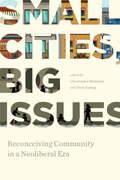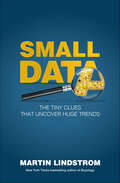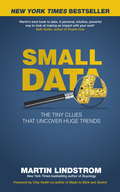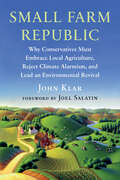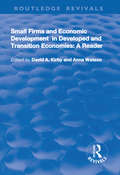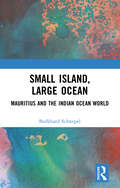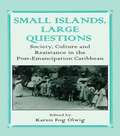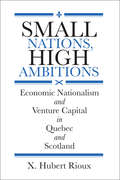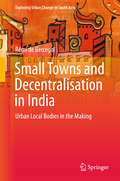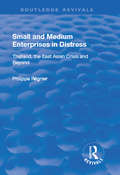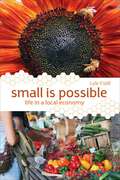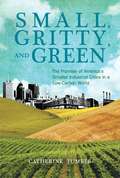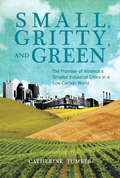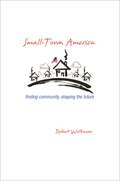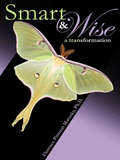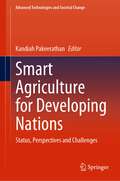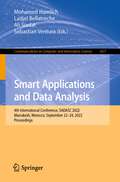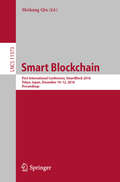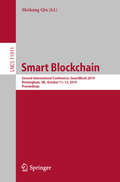- Table View
- List View
Small Cities, Big Issues: Reconceiving Community in a Neoliberal Era
by Christopher Walmsley Terry KadingSmall Canadian cities confront serious social issues as a result of the neoliberal economic restructuring practiced by both federal and provincial governments since the 1980s. Drastic spending reductions and ongoing restraint in social assistance, income supports, and the provision of affordable housing, combined with the offloading of social responsibilities onto municipalities, has contributed to the generalization of social issues once chiefly associated with Canada’s largest urban centres. As the investigations in this volume illustrate, while some communities responded to these issues with inclusionary and progressive actions others were more exclusionary and reactive—revealing forms of discrimination, exclusion, and “othering” in the implementation of practices and policies. Importantly, however their investigations reveal a broad range of responses to the social issues they face. No matter the process and results of the proposed solutions, what the contributors uncovered were distinctive attributes of the small city as it struggles to confront increasingly complex social issues. If local governments accept a social agenda as part of its responsibilities, the contributors to Small Cities, Big Issues believe that small cities can succeed in reconceiving community based on the ideals of acceptance, accommodation, and inclusion.
Small Data: The Tiny Clues That Uncover Huge Trends
by Martin LindstromMartin Lindstrom, a modern-day Sherlock Holmes, harnesses the power of “small data” in his quest to discover the next big thingHired by the world's leading brands to find out what makes their customers tick, Martin Lindstrom spends 300 nights a year in strangers’ homes, carefully observing every detail in order to uncover their hidden desires, and, ultimately, the clues to a multi-million dollar product. Lindstrom connects the dots in this globetrotting narrative that will enthrall enterprising marketers, as well as anyone with a curiosity about the endless variations of human behavior. You’ll learn…• How a noise reduction headset at 35,000 feet led to the creation of Pepsi’s new trademarked signature sound.• How a worn down sneaker discovered in the home of an 11-year-old German boy led to LEGO’s incredible turnaround.• How a magnet found on a fridge in Siberia resulted in a U.S. supermarket revolution.• How a toy stuffed bear in a girl’s bedroom helped revolutionize a fashion retailer’s 1,000 stores in 20 different countries.• How an ordinary bracelet helped Jenny Craig increase customer loyalty by 159% in less than a year.• How the ergonomic layout of a car dashboard led to the redesign of the Roomba vacuum.
Small Data: The Tiny Clues That Uncover Huge Trends
by Martin Lindstrom CompanyThe New York Times Bestseller named one of the "Most Important Books of 2016" by Inc, and a Forbes 2016 "Must Read Business Book"'If you love 'Bones' and 'CSI', this book is your kind of candy' Paco Underhill, author of Why We Buy'Martin's best book to date. A personal, intuitive, powerful way to look at making an impact with your work' Seth Godin, author of Purple CowMartin Lindstrom, one of Time Magazine's 100 Most Influential People in The World and a modern-day Sherlock Holmes, harnesses the power of "small data" in his quest to discover the next big thing.In an era where many believe Big Data has rendered human perception and observation 'old-school' or passé, Martin Lindstrom shows that mining and matching technological data with up-close psychological insight creates the ultimate snapshot of who we really are and what we really want. He works like a modern-day Sherlock Holmes, accumulating small clues - the progressively weaker handshakes of Millenials, a notable global decrease in the use of facial powder, a change in how younger consumers approach eating ice cream cones - to help solve a stunningly diverse array of challenges. In Switzerland, a stuffed teddy bear in a teenage girl's bedroom helped revolutionise 1,000 stores - spread across twenty countries - for one of Europe's largest fashion retailers. In Dubai, a distinctive bracelet strung with pearls helped Jenny Craig offset its declining membership in the United States and increase loyalty by 159% in only one year. In China, the look of a car dashboard led to the design of the iRobot, or Roomba, floor cleaner - a great success story.SMALL DATA combines armchair travel with forensic psychology in an interlocking series of international clue-gathering detective stories. It shows Lindstrom using his proprietary CLUES Framework - where big data is merely one part of the overall puzzle - to get radically close to consumers and come up with the counter-intuitive insights that have in some cases helped transform entire industries. SMALL DATA presents a rare behind-the-scenes look at what it takes to create global brands, and reveals surprising and counter-intuitive truths about what connects us all as humans.
Small Farm Republic: Why Conservatives Must Embrace Local Agriculture, Reject Climate Alarmism, and Lead an Environmental Revival
by John Klar&“I have read at least 20 books a year for the past 25 years and Small Farm Republic is absolutely one of the very best that I have ever read. . . A must-read not only for those involved in all facets of agriculture but policy makers and consumers as well.&”—Gabe Brown, regenerative rancher, author of Dirt to SoilFrom farmer, lawyer, and political activist John Klar comes a bold, solutions-based plan for Conservatives that gets beyond the fatuous pipe dreams and social-justice platitudes of the dominant, Liberal &“Green&” agenda—offering a healthy way forward for everyone.While many on the Left have taken up the mantle of creating a &“green&” future through climate alarmism, spurious new energy sources, and technocratic control, many on the Right continue to deny imminent environmental threats while pushing for unbridled deregulation of our most destructive industrial forces. Neither approach promises a bright future.In a time of soil degradation, runaway pollution, food insecurity, and declining human health, the stakes couldn&’t be higher, and yet the dominant political voices too often overlook the last best hope for our planet—supporting small, regenerative farmers. In fact, politicians on all sides continue to sell out the interests of small farmers to the devastating power of Big Ag and failed &“renewable energy&” incentives. It&’s time for a new vision. It&’s time for bold new agriculture policies that restore both ecosystems and rural communities.In Small Farm Republic, John Klar, an agrarian conservative in the mold of Wendell Berry and Joel Salatin, offers an alternative that puts small farmers, regenerative agriculture, and personal liberty at the center of an environmental revival—a message that everyone on the political spectrum needs to hear.
Small Farms: Persistence With Legitimation
by Alessandro BonannoWhy do small farms continue to coexist with ever-larger farming operations in advanced Western societies? Through a thorough case study of Italy and a comparative analysis of small farms in the United States, Dr. Bonanno seeks to answer this question, exploring the complex relationships among farm family members’ ideology and behavior, the small farm economic sector, and the interaction of small farms within the relevant spheres of society. He finds that, at the structural level, a lack of occupational alternatives and contradictions within both labor and land markets often force farmers to retain marginal farms despite personal dissatisfaction. At the ideological level, many farm families display deep attachment to the agrarian way of life and cite this as a fundamental reason for not leaving the farm for other work. Dr. Bonanno also analyzes the role of small farms within the social system and concludes that they serve a legitimative function. This legitimative role fosters contradictions within the social and economic systems that the state is unable to resolve, thus contributing to the continuation of a dual structure in agricultural development-Ö¾large and very large farms at one end of the scale and marginal but persistent small farms at the other.
Small Firms and Economic Development in Developed and Transition Economies: A Reader (Routledge Revivals Ser.)
by David A. Kirby Anna WatsonThis title was first published in 2003. Since the late 1970s there has been considerable interest in the role of small firms in economic development in general and employment generation in particular. Throughout the developed world, governments have introduced a range of measures to encourage small firm growth and development in an attempt to stimulate economic growth, generate employment and foster innovation. Though not all measures have been successful many policies have transferred to the transition economies of Central and Eastern Europe where, since 1989, small firm growth and development has achieved considerable importance in economic restructuring. Accordingly, this volume presents the leading research on the role of small firms in economic development and employment generation in both transition and developed countries. Setting itself in a wider theoretical context, the book also considers the implications for both policy and theory and suggests directions for future research.
Small Groups: Key Readings (Key Readings in Social Psychology)
by John M. Levine Richard L. MorelandResearch on small groups is highly diverse because investigators who study such groups vary in their disciplinary identifications, theoretical interests, and methodological preferences. The goal of this volume is to capture that diversity, and thereby convey the breadth and excitement of small group research by acquainting students with work on five fundamental aspects of groups. The volume also includes an introductory chapter by the editors which provides an overview of the history of and current state-of-the-art in the field. Together with introductions to each section, discussion questions and suggestions for further reading, make the volume ideal reading for senior undergraduate and graduate students interested in group dynamics.
Small Island, Large Ocean: Mauritius and the Indian Ocean World
by Burkhard SchnepelThis book is about a ‘Small Island’, namely Mauritius in the southwestern Indian Ocean. It is also about a ‘Large Ocean’, the Indian Ocean world—its peoples, histories and cultures. It casts light on the life of an island through what is known not only about the island itself, but also through what is known about the wider Indian Ocean world. It is also about the Indian Ocean world in that it focuses on an island, which, in many senses and dimensions, is not only a model of, but in some respects also a model for wider developments and features of relevance to the Indian Ocean world as a whole.
Small Islands, Large Questions: Society, Culture and Resistance in the Post-Emancipation Caribbean
by Karen Fog OlwigThis book focuses on the post-emancipation period in the Caribbean and how local societies dealt with the new socio-economic conditions. Scholars from Jamaica, the Virgin Islands, England, Denmark and The Netherlands link this era with the contemporary Caribbean.
Small Nations, High Ambitions: Economic Nationalism and Venture Capital in Quebec and Scotland (Studies in Comparative Political Economy and Public Policy)
by X. Hubert RiouxGiven the importance that entrepreneurship and start-up businesses in technology-intensive sectors like life sciences, renewable energy, artificial intelligence, financial technologies, software and others have come to assume in economic development, the access of entrepreneurs to appropriate levels of finance has become a major focus of policymakers in recent decades. Yet, this prominence has led to a variety of policy models across countries and even within countries, as different levels of government have adapted to new challenges by refining or transforming pre-existing institutions and crafting new policy tools. Small Nations, High Ambitions investigates the roots of such policy diversity at the “subnational” level, offering in-depth accounts of the evolution of Quebec’s and Scotland’s policy strategies in the entrepreneurial finance sector and venture capital more specifically. As compared to other regions and provinces in the United Kingdom and Canada, Quebec and Scottish venture capital ecosystems rely on a high degree of state intervention, either direct (through public investment funds) or indirect (through government-backed, hybrid, or tax-advantaged funds). These two regions can thus be described as “sponsor states,” heavily involved in the strategic backing of innovative businesses. Whereas most of the literature on venture capital has focused on economic variables to explain variations in policy models, this book seeks to explain policy divergence in Quebec and Scotland through political and ideological lenses. Its main argument is that the development of venture capital ecosystems in these regions was underpinned by Québécois and Scottish nationalisms, which induced preferences for policy asymmetry and state intervention.
Small Talk (Language In Social Life)
by Justine CouplandThis study presents a new perspective on small talk and its crucial role in everyday communication. The new approach presented here is supported by analyses of interactional data in specific settings - private and public, face-to-face and telephone talk. They vary from gossip at the family dinner table and intimate 'keeping in touch' phone conversations, to interpersonally-focused talk in institutional settings, such as the government office and the university research seminar. Drawing on a range of methodological approaches, including Discourse Analysis and Pragmatics, Interpersonal Communication and Conversation Analysis, the author elevates small talk to a new status, as functionally multifaceted, but central to social interaction as a whole.
Small Towns and Decentralisation in India
by Rémi BercegolThis book examines the impact that decentralisation reforms, initiated in the early 1990s, have had on small towns in India. It specifically focuses on small towns in Uttar Pradesh, one of the most densely populated and poorest states in India. Although considered home to one of the oldest urban civilisations, India remains one of the least urbanised regions in the world. At the same time, the country has many million-strong metropolises that are among the world's largest megacities, as well as a multitude of small and medium-sized towns and cities. This paradoxical urbanisation, against a backdrop of reforms, has interested the scientific community to gain a more nuanced understanding of the changes and challenges involved. This book analyses an urban environment often overlooked by researchers and public authorities, namely, that of small towns. These towns are of vital importance as this is where the bulk of future urban development will take place. However, decades after implementation of the reforms, the majority of reviews and assessments have focused on large cities and so the impacts of the reform on small towns are still poorly understood. This book includes extensive primary data about political, technical and financial municipal issues in small towns of northern India and, is therefore, of interest to students, researchers and planners working on urban and regional studies in the global South.
Small and Medium Enterprises in Distress: Thailand, the East Asian Crisis and Beyond
by Philippe RegnierThis title was first published in 2000: Since 1998, there have been many diagnoses, studies and theories attempting to explain the East Asian economic crisis and the impact on major economic and financial sectors. This text aims to fill a gap in the literature by examining the effects on small and medium-sized enterprises. From early 1998, unemployment figures in the region rose rapidly although large enterprises were not as yet engaged in corporate restructuring. Registered small and medium-sized enterprises (SMEs) and microenterprises were a major source of this unemployment, especially among unskilled and seasonal workers. This volume covers the debate in five ways. An introductory chapter presents an overview of the SME international experience both in OECD and developing economies. Part I looks at the economic and social contribution of SMEs in Thailand before and after the 1997-1998 crisis and Part II reviews government policy and SME promotion initiatives. Part III explores the assumption that local SMEs linked to large firms have been more resilient, while the concluding chapter suggests a range of policies which have been derived from experiences in places other than Thailand.
Small is Democratic: An Examination of State Size and Democratic Development
by Dana OttFirst published in 2001. Routledge is an imprint of Taylor & Francis, an informa company.
Small is Possible: Life in a Local Economy
by Lyle EstillIn an era when incomprehensibly complex issues like Peak Oil and Climate Change dominate headlines, practical solutions at a local level can seem somehow inadequate.In response, Lyle Estill's Small is Possible introduces us to "hometown security," with this chronicle of a community-powered response to resource depletion in a fickle global economy. True stories, springing from the soils of Chatham County, North Carolina, offer a positive counter balance to the bleakness of our age.This is the story of how one small southern US town found actual solutions to actual problems. Unwilling to rely on government and wary of large corporations, these residents discovered it is possible for a community to feed itself, fuel itself, heal itself and govern itself.This book is filled with newspaper columns, blog entries, letters and essays that have appeared on the margins of small town economies. Tough subjects are handled with humor and finesse. Compelling stories of successful small businesses from the grocery co-op to the biodiesel co-op describe a town and its people on a genuine quest for sustainability.Everyone interested in sustainability, local economy, small business, and whole foods will be inspired by the success stories in this book.
Small, Gritty, and Green
by Catherine TumberAmerica's once-vibrant small-to-midsize cities--Syracuse, Worcester, Akron, Flint, Rockford, and others--increasingly resemble urban wastelands. Gutted by deindustrialization, outsourcing, and middle-class flight, disproportionately devastated by metro freeway systems that laid waste to the urban fabric and displaced the working poor, and struggling with pockets of poverty reminiscent of postcolonial squalor, small industrial cities--as a class--have become invisible to a public distracted by the Wall Street (big city) versus Main Street (small town) matchup. These cities would seem to be part of America's past, not its future. And yet, journalist and historian Catherine Tumber argues in this provocative book, America's gritty Rust Belt cities could play a central role in a greener, low-carbon, relocalized future. As we wean ourselves from fossil fuels and realize the environmental costs of suburban sprawl, we will see that small cities offer many assets for sustainable living not shared by their big city or small town counterparts: population density (and the capacity for more); fertile, nearby farmland available for local agriculture, windmills, and solar farms; and manufacturing infrastructure and workforce skill that can be repurposed for the production of renewable technology. Tumber, who has spent much of her life in Rust Belt cities, traveled to twenty-five cities in the Northeast and Midwest--from Buffalo to Peoria to Detroit to Rochester--interviewing planners, city officials, and activists, and weaving their stories into this exploration of small-scale urbanism. Smaller cities can be a critical part of a sustainable future and a productive green economy. Small, Gritty, and Green will help us develop the moral and political imagination we need to realize this.
Small, Gritty, and Green: The Promise of America's Smaller Industrial Cities in a Low-Carbon World (Urban and Industrial Environments)
by Catherine TumberHow small-to-midsize Rust Belt cities can play a crucial role in a low-carbon, sustainable, and relocalized future.America's once-vibrant small-to-midsize cities—Syracuse, Worcester, Akron, Flint, Rockford, and others—increasingly resemble urban wastelands. Gutted by deindustrialization, outsourcing, and middle-class flight, disproportionately devastated by metro freeway systems that laid waste to the urban fabric and displaced the working poor, small industrial cities seem to be part of America's past, not its future. And yet, Catherine Tumber argues in this provocative book, America's gritty Rust Belt cities could play a central role in a greener, low-carbon, relocalized future.As we wean ourselves from fossil fuels and realize the environmental costs of suburban sprawl, we will see that small cities offer many assets for sustainable living not shared by their big city or small town counterparts, including population density and nearby, fertile farmland available for new environmentally friendly uses.Tumber traveled to twenty-five cities in the Northeast and Midwest—from Buffalo to Peoria to Detroit to Rochester—interviewing planners, city officials, and activists, and weaving their stories into this exploration of small-scale urbanism. Smaller cities can be a critical part of a sustainable future and a productive green economy. Small, Gritty, and Green will help us develop the moral and political imagination we need to realize this.
Small- And Medium-scale Industries In The Asean Countries: Agents Or Victims Of Economic Development?
by Ulrich Hiemenz Mathias BruchSmall- and Medium-Scale Industries in the ASEAN Countries is a comparative study of SMIs in the five member countries of the Association of Southeast Asian Nations (ASEAN), analyzing the performance of SMIs to generate income and employment.
Small-Area Estimates of School-Age Children in Poverty: Evaluation of 1995 County and School District Estimates for Title I Allocations
by Panel on Estimates of Poverty for Small Geographic AreasThe National Academies Press (NAP)--publisher for the National Academies--publishes more than 200 books a year offering the most authoritative views, definitive information, and groundbreaking recommendations on a wide range of topics in science, engineering, and health. Our books are unique in that they are authored by the nation's leading experts in every scientific field.
Small-Town America: Finding Community, Shaping the Future
by Robert WuthnowA revealing examination of small-town lifeMore than thirty million Americans live in small, out-of-the-way places. Many of them could have joined the vast majority of Americans who live in cities and suburbs. They could live closer to more lucrative careers and convenient shopping, a wider range of educational opportunities, and more robust health care. But they have opted to live differently.In Small-Town America, we meet factory workers, shop owners, retirees, teachers, clergy, and mayors—residents who show neighborliness in small ways, but who also worry about everything from school closings and their children's futures to the ups and downs of the local economy. Drawing on more than seven hundred in-depth interviews in hundreds of towns across America and three decades of census data, Robert Wuthnow shows the fragility of community in small towns. He covers a host of topics, including the symbols and rituals of small-town life, the roles of formal and informal leaders, the social role of religious congregations, the perception of moral and economic decline, and the myriad ways residents in small towns make sense of their own lives. Wuthnow also tackles difficult issues such as class and race, abortion, homosexuality, and substance abuse.Small-Town America paints a rich panorama of individuals who reside in small communities, finding that, for many people, living in a small town is an important part of self-identity.
Smart & Wise: A Transformation
by Florence Pittman MatuskyFlorence Matusky proposes that K-12 public education's primary focus on one hemisphere only (the left-brain) - to be test smart,not wise - produces students whose impoverished, "approved" knowledge is not for understanding self,others,or how to live,but for programming them with by-the-book,academic knowledge then reducing them to numbers.The rationale for flourish or perish ensures failures and dropouts; fosters poverty,crime,violence,addictions,greed,or selfishness;and jeopardizes two of America's Four Freedoms (freedom from fear and want).No one comes into this world and to school with a clean slate. We are born self-centered to get our survival needs met and with inherited and experiential embedded data from conception onward.All children and adults need to express their significance. When children experience being loved,respected, and their embedded true life stories - which are played out as behavior,appearance,and capacity to learn in school - are heard, understood, and accepted, then they learn to love, respect, and accept themselves and others "as is." Released from ego deficits and negativity,they are present to their full human intelligence.When the invisible curriculum(self-awareness, humane redevelopment, emotional resilience, virtues, and character) is not taught and modeled at home and in K-12 public schools,children's uneducated egos and passion and/or lack of meaning and respect override cognition,creating anti-social acts and unsafe societies. As adults, many seek significance outside themselves: power-over people,wealth, and/or the world's stage, creating wars, economic bubbles, income inequality,and declining human qualities and inner lives.Our societal ills are reflections of The Western Intellectual Tradition's legacy. Smart & Wise offers reasons for and solutions to America's quantitative, unequal public schools so students may rise to their higher faculties and excel in math,reading,science,innovation,communications,and relationships.
Smart Agriculture for Developing Nations: Status, Perspectives and Challenges (Advanced Technologies and Societal Change)
by Kandiah PakeerathanThis book in its eighteen chapters provides sustainable and smart technology-based solutions to developing nations. Smart farming is growing in importance due to the increasing demand for higher crop yield, the need for using natural resources efficiently, the rising use and sophistication of information and communication technology and the increasing need for climate-smart agriculture. Some of these chapters deal with the applications of smart agriculture to address the special challenges of the Small Island Developing States for sustainable agriculture. The book brings together scientific communities from India, Indonesia, Iraq, Malaysia, Mauritius, Myanmar, Palestine, Sri Lanka and South Africa to share their expertise to make the farming system more connected and intelligent. The smart farming techniques shared in different chapters not only help to reduce the overall cost and improve the quality and quantity of products but altogether help improve the sustainability of agriculture in the developing world.‘Smart Farming’ is a management concept focused on providing the agricultural industry with the infrastructure to leverage advanced technologies—including artificial intelligence (AI), big data, robotics, drones and Internet of Things (IoT)—for tracking, monitoring, automating and analyzing operations. Sometimes known as precision agriculture, smart farming is software managed and sensor monitored.
Smart Applications and Data Analysis: 4th International Conference, SADASC 2022, Marrakesh, Morocco, September 22–24, 2022, Proceedings (Communications in Computer and Information Science #1677)
by Ladjel Bellatreche Mohamed Hamlich Sebastian Ventura Ali SiadatThis book constitutes the refereed proceedings of the 4th International Conference onSmart Applications and Data Analysis, SADASC 2022, held in Marrakesh, Morocco,during September 22–24, 2022.The 24 full papers and 11 short papers included in this book were carefully reviewed andselected from 64 submissions. They were organized in topical sections as follows: AI-Driven Methods 1; Networking technologies & IoT; AI-Driven Methods 2; Green Energy, Computing and Technologies 1; AI-Driven Methods 3; Green Energy, Computing and Technologies 2; Case studies and Cyber-Physical Systems 1; Case studies and Cyber-Physical Systems 2; and Case studies and Cyber-Physical Systems 3.
Smart Blockchain: First International Conference, SmartBlock 2018, Tokyo, Japan, December 10–12, 2018, Proceedings (Lecture Notes in Computer Science #11373)
by Meikang QiuThis book constitutes the refereed proceedings of the First International Conference on Smart Blockchain, SmartBlock 2018, held in Tokyo, Japan, in December 2018. The 17 papers presented in this volume were carefully reviewed and selected from 102 submissions. They focus on a broad range of topics in the area of blockchain, from privacy-preserving solutions to designing advanced blockchain mechanism, from empirical studies to practical manuals.
Smart Blockchain: Second International Conference, SmartBlock 2019, Birmingham, UK, October 11–13, 2019, Proceedings (Lecture Notes in Computer Science #11911)
by Meikang QiuThis book constitutes the refereed proceedings of the Second International Conference on Smart Blockchain, SmartBlock 2019, held in Birmingham, UK, in October 2019.The 13 papers presented in this volume were carefully reviewed and selected from 100 submissions. They focus on a broad range of topics in the area of blockchain, from privacy-preserving solutions to designing advanced blockchain mechanism, from empirical studies to practical manuals.
